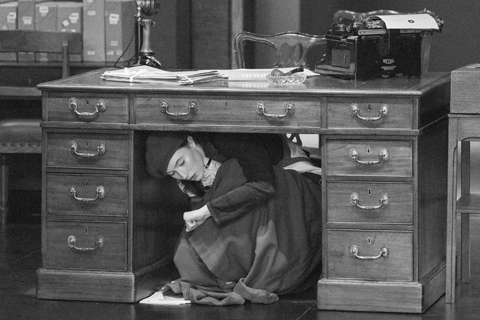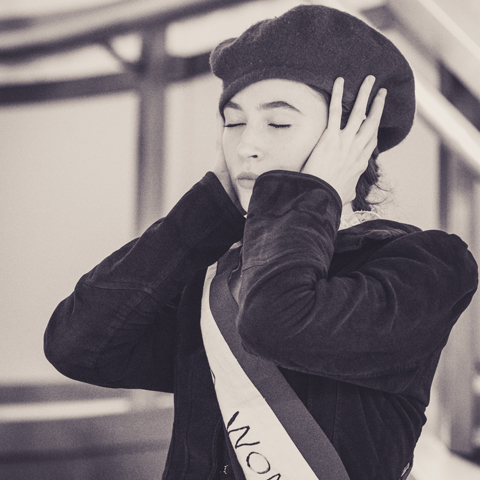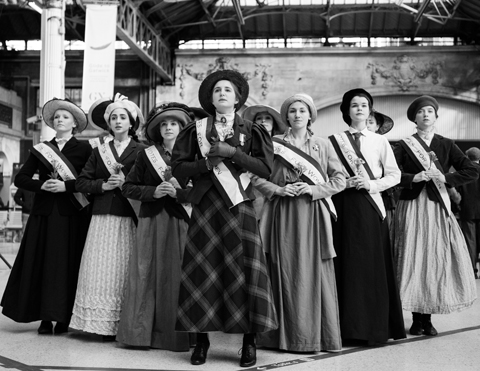Badged, “The Year of the Woman”, 2018 has not only seen many of its dates linked to the suffrage movement but has also witnessed events such as the #MeToo and #PayMeToo campaigns and several women’s marches. On 6 February, this year, the 100th anniversary of UK women of 30+ receiving the vote, an eye-catching and unexpected event greeted commuters at London’s Victoria Station. A flash mob dance performance linked tales of the suffragette battle with current gender topics.
The 100nehundred cast of 70 dancers included our company professionals, together with groups from Rambert School and West London, with huge thanks to our key sponsors Victoria BID, our delivery partners The National Archives and Rambert School.
Victoria Station was chosen because it was the starting point for a funeral procession that followed the coffin of Emily Wilding Davison as it was transported across London, in 1913. The famous suffragette had been killed by King George V’s horse Anmer as she ran on to protest at the Epsom Derby. Victoria was also where she had embarked on her journey from London to Epsom, that fateful day.
Emily Wilding Davison
We learned much about Emily Wilding Davison, whose story is fundamental to our project, thanks to passionate archivists and an inspirational relative of Emily, called Philippa Bilton.
Emily, a strong, intelligent and determined woman, faced many harsh gender barriers. She studied at Royal Holloway College and Oxford University but was denied the opportunity to gain an official degree because she was female. Emily later devoted herself to full-time work for the suffragette cause; she wrote repeatedly to the authorities and was arrested and imprisoned many times.
Our most recent event, on 4 July, at The National Archives, featured Eve Dobel in a site-specific solo using silent disco headphones. It depicted Emily’s witty and adventurous side, hiding in a cupboard at the House of Commons during census night, 1911, so that she could use the prestigious address on her form.


The dance also included an incident from Emily’s time in prison. So moved by screams of fellow suffragettes being force-fed, Emily decided to throw herself off a balcony, her idea being that one big tragedy may save many others. It is important to know that force-feeding was horrific and painful, sometimes resulting in teeth being ripped out.

A short film of Emily’s last journey, called “Deeds not Words,” premiered after the live show on 6 February. I had already thought about showing a dancer walking in Emily’s footsteps to Epsom, early in 2017, and as I researched I began wondering what Emily would have thought about present day issues - Trump, #Me Too, gender pay gap, violence towards women and so on.
On a winter’s day, our collaborators accompanied us to Epsom Downs Racecourse, where we were warmly entertained. Sheltering from the freezing, wet weather, warming our hands with a hot drink we reflected on this momentous event in the struggle for women’s emancipation. Emotions ran high as we filmed at the spot where Emily died. At the time, Emily was vilified in the press as a mad woman but we know now that she had a return ticket and her probable intention was not to commit suicide but to attach a “votes for women” scarf to a horse’s bridle so that it would be flown as the horse crossed the finish line. In paying the ultimate sacrifice she did, however, change the face of history.
As our project developed, supported by key partners and venues, the feeling grew that this was truly a transformative moment. Emily Davison and Victoria Station are irrevocably linked and this venue provided the perfect launch for 100nehundred. An unforgettable, poignant moment occurred during the dance when a group of shouting dancers recreated Derby Day 1913 and Emily ducked under the barrier. Anticipation was high as dancer Chloe Mead threw the scarf and tears soon came to the eyes of many onlookers. One lady ran forward to applaud the cast as if to right a long-standing wrong.
Learning from the public
Since March we have worked with more than 1000 people from schools, colleges and community groups across London. It has been a wonderful, exhilarating experience to create performances and films with so many people and it has been a fantastic learning curve for me personally. In July, we remembered the 90 years since women received equal voting rights with men as we invited 100 Londoners of all ages to perform inside The National Archives building in Kew, where the dancers both reflected on the past and addressed current gender issues in their unique style.
You will find great photos and films on our dedicated project page. Chance remarks can be so stimulating, like the comment of a 10-year-old boy from Twickenham, who said, “It doesn’t matter what gender you are, we are all equal anyway!”
The impact of all this year’s activities has been considerable yet certain global and domestic matters remain - the long-standing gender pay gap; the FGM crisis; violence against women, including rape; and the lack of female representation in politics and big business, to name a few. This must be the year that we pick up the baton of the suffragettes and advance towards the finish line.
As a female choreographer, I am part of an industry where the rights of women are being neglected. Whilst training I learned about many innovators of classical and modern dance, people like Martha Graham, Isadora Duncan, Dame Marie Rambert and Dame Ninette de Valois - all of them sisters doin’ it for the dance scene!
Yet after graduation, I soon realised that the dance world had changed significantly since the era of Martha Graham. Let’s face it, large-scale, prestigious commissions are rarely offered to female choreographers. Many pertinent questions are asked through blogs and forums but is any actual change taking place? How has this become the norm?
Combination Dance Company is in discussions with some superb collaborators and venues regarding both our site-specific piece and the restaging of the films with new and impressive twists. There is still a great deal to be done concerning gender inequalities before real change can take place.
How about calling 2019 “The Year of Everyone” - let’s do as the little boy from Twickenham told us; let’s recognise each other as truly equal!
Anne-Marie Smalldon - Combination Dance
Films created by Luke Toddfrey
Images by Scott David Photography
Costumes by Mike Lees
